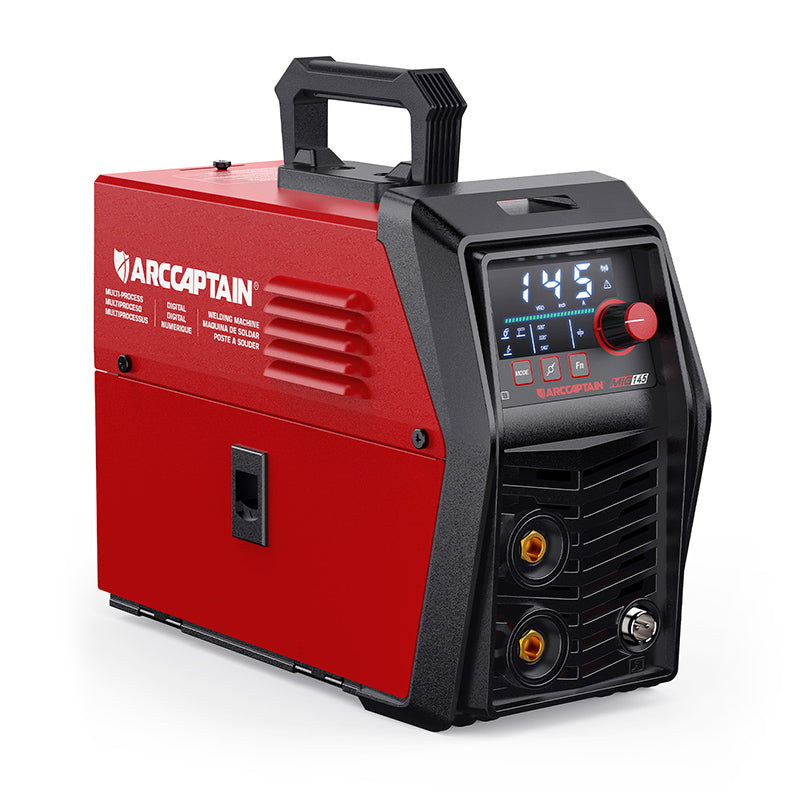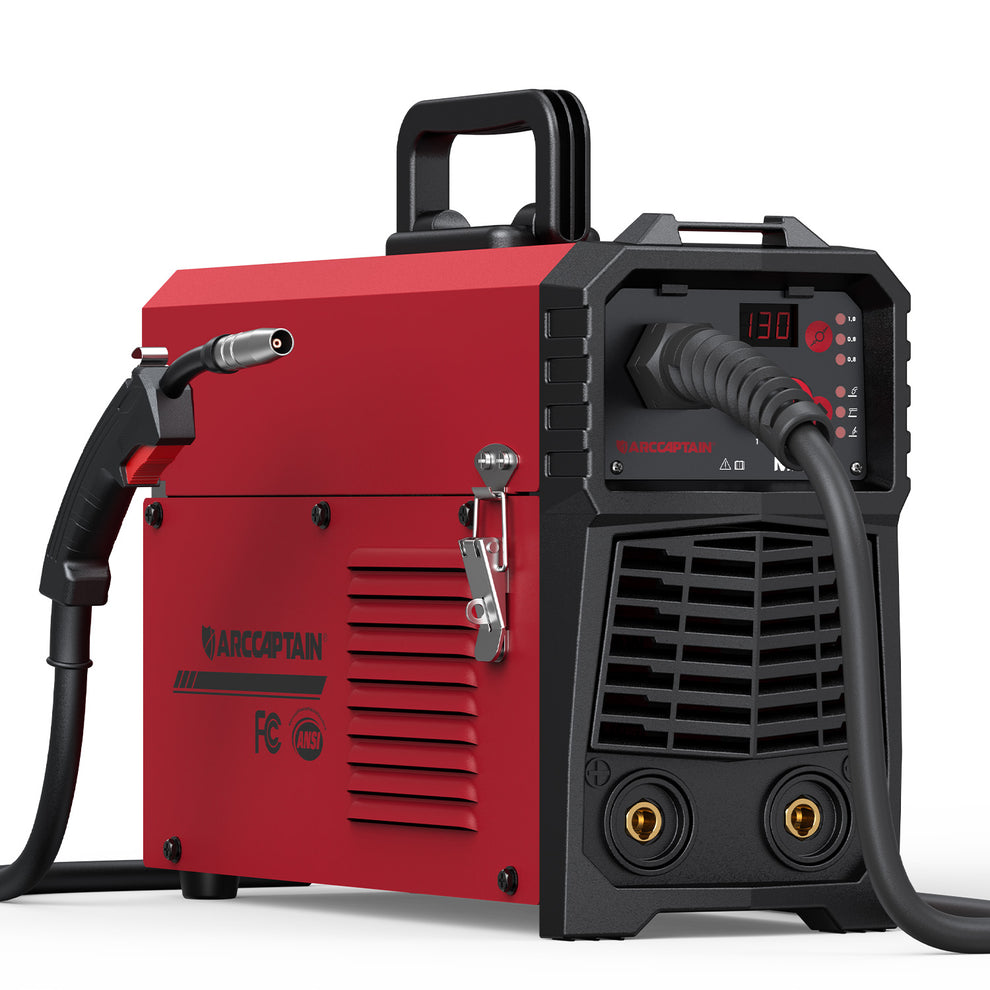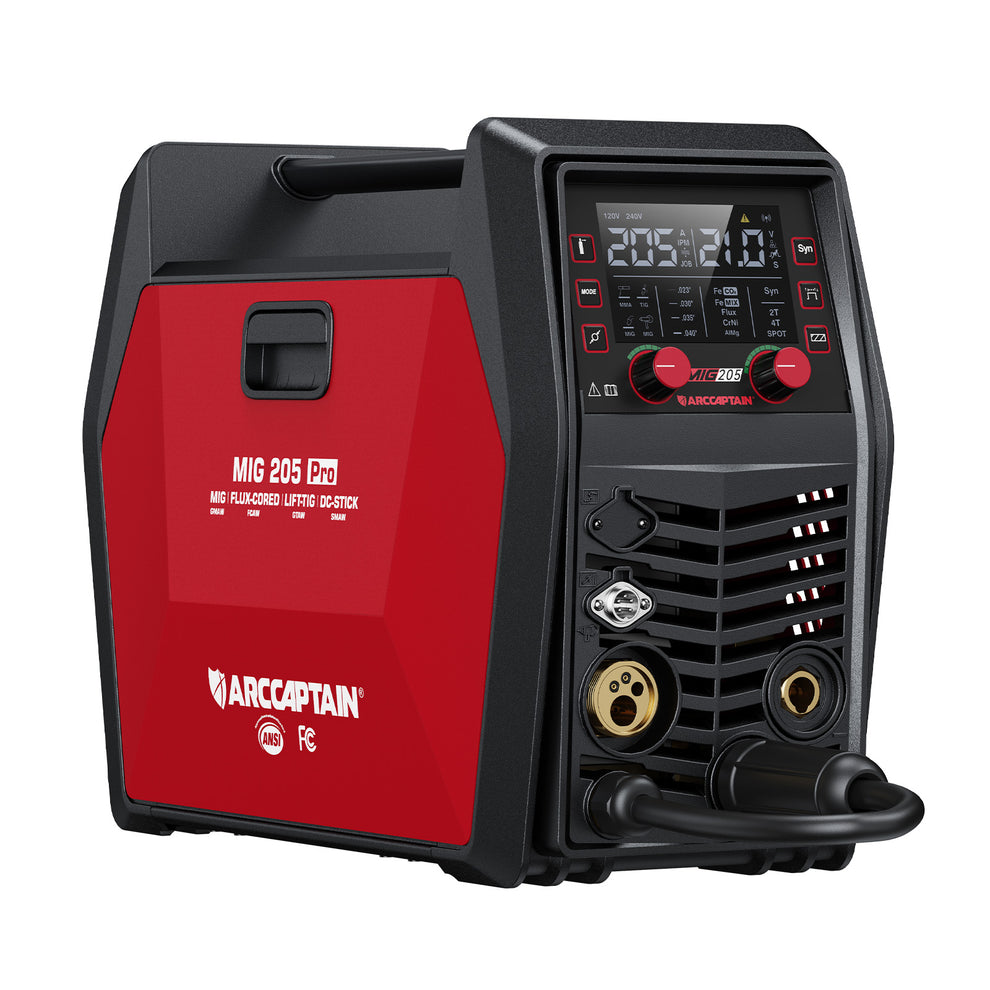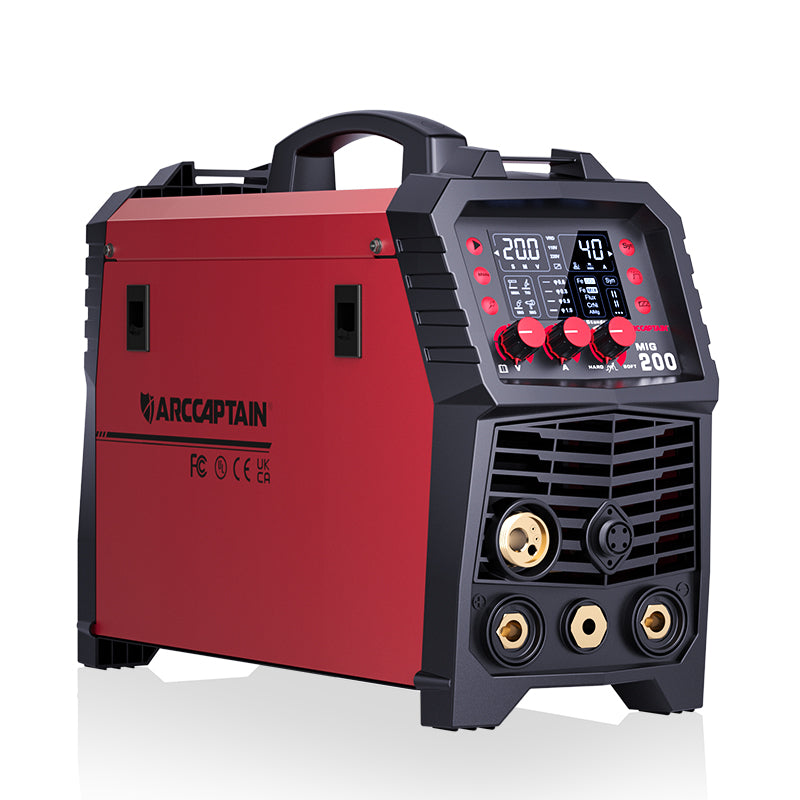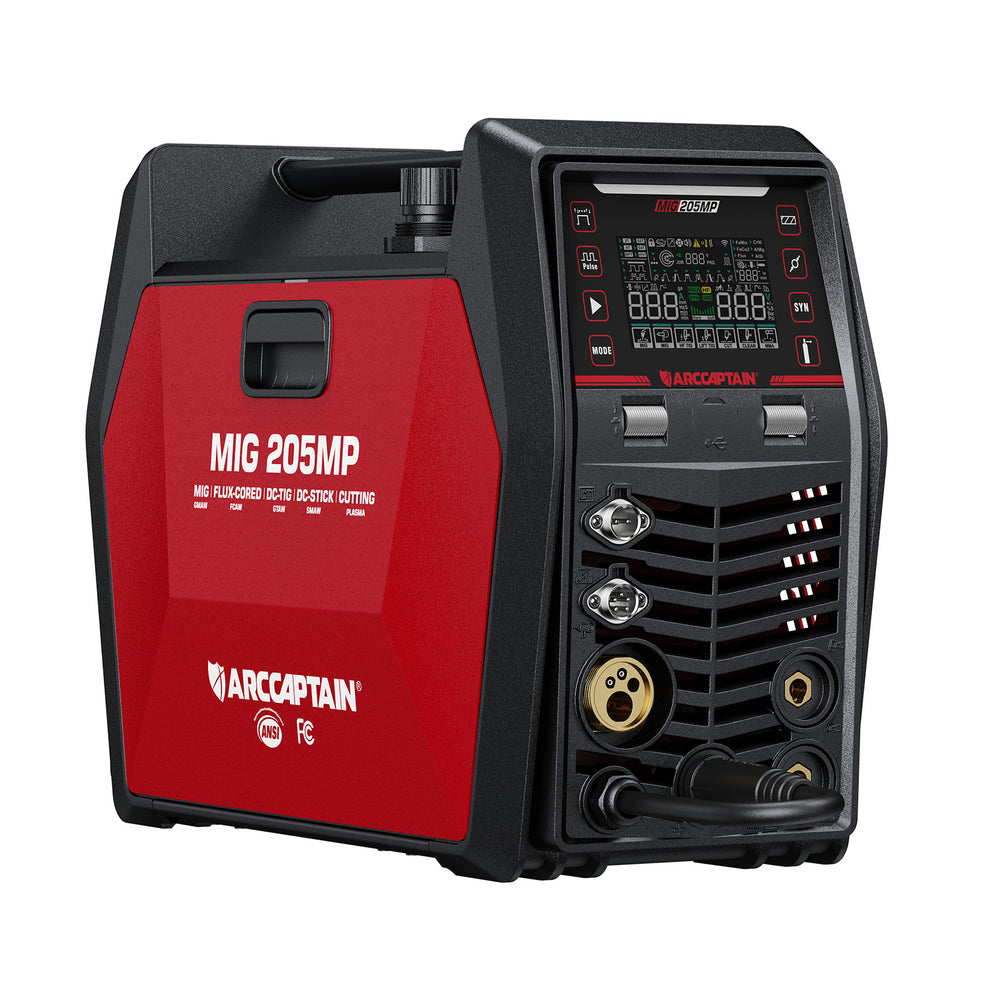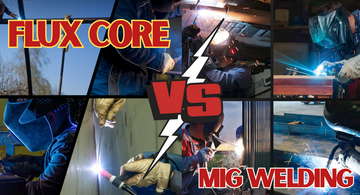
Choosing between flux-core and MIG welding can be confusing for both new and experienced welders.
Both methods use wire-fed welding machines, but they differ in key ways that affect cost, ease of use, and final results.
Understanding the differences between flux core welding and MIG helps you choose the proper process for your specific project, whether you're working indoors with thin sheet metal or outdoors with thick structural steel.
This guide breaks down the main differences, pros, and cons, as well as the best applications for each welding method.
Flux-Core vs. MIG Quick Comparison:
- Flux-core (FCAW-S) runs without gas outdoors, penetrates well, but leaves slag and more spatter.
- MIG (GMAW) uses shielding gas, resulting in cleaner beads and less cleanup, but struggles in windy conditions and requires gas bottles.
- Cost: Flux-core wire costs more but has no gas expenses; MIG wire is cheaper but has ongoing gas costs.
- Both have moderate learning curves and similar techniques.
- Use flux-core for rusty steel, thick joints, and outdoor work. Use MIG for clean, thin materials, delicate beads, and indoor fabrication.
Understanding Flux-Core Welding

Flux-core welding, also known as Flux-Cored Arc Welding (FCAW), uses a hollow wire filled with powdered flux. When the wire melts during welding, the flux creates its own protective gases and forms a slag layer over the weld.
How Flux-Core Works
- The tubular wire contains flux compounds that burn and create protective gases.
- These gases shield the molten metal from contamination without needing an external gas tank.
- The flux also forms slag that protects the cooling weld metal.
- Most flux-core welding uses "drag" technique, pulling the gun away from the direction of travel.
Key Features of Flux-Core
- No external shielding gas required for self-shielded wires.
- Higher heat input provides deep penetration on thick materials.
- Works well on slightly rusty or dirty surfaces due to the flux action.
- Produces slag that must be chipped away after welding.
👉 Read More: What is Flux Cored Arc Welding? (FCAW)
You May Want to Shop 🛒
Understanding MIG Welding

MIG welding, technically known as Gas Metal Arc Welding (GMAW), utilizes a solid metal wire fed through the gun, while an external shielding gas protects the weld area.
How MIG Works
- Solid wire melts to form the weld metal.
- Shielding gas from a pressurized tank flows around the arc to protect it from air contamination.
- Common gases include pure CO₂, or mixtures of argon and CO₂.
- Uses a "push" technique, moving the gun in the direction of travel.
Key Features of MIG
- Requires external shielding gas from a tank.
- Produces clean welds with minimal spatter and no slag.
- Better control over weld appearance and quality.
- Works excellently on thin materials without burn-through.
👉 Read More: MIG Welding Basics - A Beginner's Guide
You May Want to Shop 🛒
Flux-Core vs. MIG Welding: Head-to-Head Comparison
|
Feature |
Flux-Core |
MIG Welding |
|
Shielding Gas |
Not required |
Required |
|
Wire Type |
Tubular with flux |
Solid metal |
|
Polarity |
DC Negative (DCEN) |
DC Positive (DCEP) |
|
Cleanup Required |
Yes (slag removal) |
Minimal |
|
Wind Resistance |
Excellent |
Poor |
|
Penetration |
Deep |
Moderate |
|
Spatter |
More |
Less |
|
Portability |
High |
Lower due to gas tank |
Cost Analysis: Which is More Affordable?
Initial Setup Costs
Flux-Core:
- Basic flux-core capable welder: $200-800
- Flux-core wire: $3-5 per pound
- No gas tank, regulator, or hoses needed
- Total startup: $200-900
MIG:
- MIG welder with gas capability: $300-1000
- Shielding gas tank rental/purchase: $100-200
- Gas regulator and hoses: $50-100
- MIG wire: $2-3 per pound
- Total startup: $450-1300
Operating Costs
Flux-Core:
- Wire costs: Higher per pound, but no gas refills
- Electricity: Slightly higher due to increased heat
- Consumables: Drive rolls, contact tips, nozzles
MIG:
- Wire costs: Lower per pound
- Gas refills: $20-40 per tank, depending on size
- Electricity: Moderate consumption
- Consumables: Contact tips, nozzles, liners
When to Use Flux-Core Welding
- Structural steel fabrication: Building frames, brackets, and heavy-duty repairs.
- Outdoor welding: Construction sites, farm equipment repair, fence building.
- Thick materials: Anything over 1/8 inch thick benefits from flux-core's penetration.
- Rusty or dirty surfaces: The flux helps burn through light contamination.
- Portable welding jobs: No gas tank means easy transport to job sites.
Advantages of Flux-Core
- No gas tank needed: More portable and less setup time.
- Wind-resistant: Works in outdoor conditions with wind speeds up to 35 mph.
- Deep penetration: Excellent for structural welding and thick materials.
- Higher deposition rates: Welds faster on heavy sections.
- Forgiving of surface prep: Works on moderately dirty or rusty steel.
Disadvantages of Flux-Core
- Slag cleanup required: Must chip away slag after each pass.
- More spatter: This creates additional cleanup work around the weld area.
- Rougher appearance: Not suitable for projects requiring smooth, finished looks.
- Limited thin material use: Can easily burn through sheet metal.
- Indoor ventilation needs: Produces more fumes, requiring good ventilation.
👉 Read Related Article: How to Get the Strongest Flux-Core Weld
When to Use MIG Welding
- Automotive work: Body panels, exhaust systems, and frame repairs.
- Sheet metal fabrication: HVAC work, custom metal projects, and repairs.
- Indoor projects: Workshop fabrication where appearance matters.
- Multi-pass welding: Building up thick sections with multiple clean passes.
- Aluminum welding: With proper setup, MIG can weld aluminum effectively.
Advantages of MIG
- Clean welds: Minimal spatter and no slag to remove.
- Better control: Easier to see the weld pool and control penetration.
- Versatile: Works on materials from 24 gauge up to thick plate.
- Smooth appearance: Professional-looking welds right off the gun.
- Less fume production: Generally produces fewer harmful fumes.
Disadvantages of MIG
- Gas tank required: Less portable, adds cost and complexity.
- Wind sensitive: Even light breezes can affect shielding gas coverage.
- Surface preparation: Requires a cleaner base metal for best results.
- Higher skill for thin materials: Easy to burn through if settings aren't right.
- Ongoing gas costs: Regular tank refills add to operating expenses.
Welding Technique Differences
Flux-Core Technique
- Gun angle: Hold 10-15 degrees backward from vertical.
- Travel direction: Use the drag technique, pulling the gun away from the direction of travel.
- Speed: Move faster to prevent excessive heat buildup.
- Position: Works well in all positions but excels in flat and horizontal.
MIG Technique
- Gun angle: Hold 10-15 degrees forward in the direction of travel.
- Travel direction: Use the push technique, pushing the gun forward.
- Speed: Moderate travel speed for good fusion and appearance.
- Gas coverage: Maintain proper standoff distance for good gas shielding.
👉 Read Related Article:
Equipment Setup Differences
Flux-Core Setup
- Polarity: Set to DC negative (electrode negative).
- Drive rolls: Use knurled or V-groove rolls for better grip on tubular wire.
- Contact tip: Slightly larger diameter than solid wire equivalent.
- Nozzle: The gas nozzle can be removed to prevent spatter buildup.
MIG Setup
- Polarity: Set to DC positive (electrode positive).
- Drive rolls: Use smooth V-groove rolls to prevent wire damage.
- Gas flow: Set 15-25 CFH depending on conditions.
- Contact tip: Match tip size exactly to wire diameter.
👉 Read Related Article: FCAW vs. GMAW: Understanding the Key Differences in Welding Techniques
Final Thoughts
The choice between flux-core and MIG welding depends on your specific needs, working environment, and project requirements.
Flux-core excels in outdoor structural applications where portability and deep penetration are most important. MIG welding shines for indoor work, thin materials, and projects where a clean appearance is important.
Many professional welders use both methods, choosing the right tool for each specific job. As you gain experience, you'll develop preferences based on your typical projects and working conditions.
Ready to get started with either welding process? Check out quality equipment and supplies from trusted manufacturers:
FAQs About Flux-core welding vs. MIG
Is flux core welding considered MIG welding?
People often lump them together, but they are different processes. MIG uses a solid wire with external shielding gas. Flux-core uses a tubular wire with flux inside, and it can be self-shielded or gas-shielded. Both use a wire feeder and a gun, but consumables and settings are not the same.
Is flux core the strongest weld?
“Strongest” depends on the joint, base metal, filler, and settings. Gas-shielded flux-core can produce very strong, code-quality welds with high deposition, especially on thicker steel. Self-shielded flux-core is tough and great outdoors, but can show more spatter and porosity if the technique or prep is poor. For thin sheet and clean indoor work, MIG often gives smoother, reliable results.
Can I switch my MIG welder to run flux-core?
Yes, most MIG machines can run flux-core wire. For self-shielded flux-core, change polarity to DCEN, install a knurled drive roll, fit the right contact tip, load flux-core wire, and shut off the gas. Adjust voltage and wire feed per the wire maker’s chart. For gas-shielded flux-core, use the recommended gas and keep DCEP unless the datasheet says otherwise.
Which is better for beginners, flux-core or MIG?
MIG is usually easier indoors on clean, thin metal because the arc is smooth and cleanup is light. Flux-core works better outside or on steel with light rust or mill scale, since it tolerates wind and dirt, but it makes more spatter and slag. If you have a garage setup and gas, start with MIG. If you will weld outdoors or on farm steel, self-shielded flux-core is a practical first choice.
Do I need gas for flux-core?
Self-shielded flux-core does not need gas, the flux makes its own shield. Gas-shielded flux-core does require the correct shielding gas, often 100% CO₂ or a CO₂/argon mix. Check the wire data sheet for the exact gas and flow rate. Using the wrong setup can cause porosity and weak welds.

